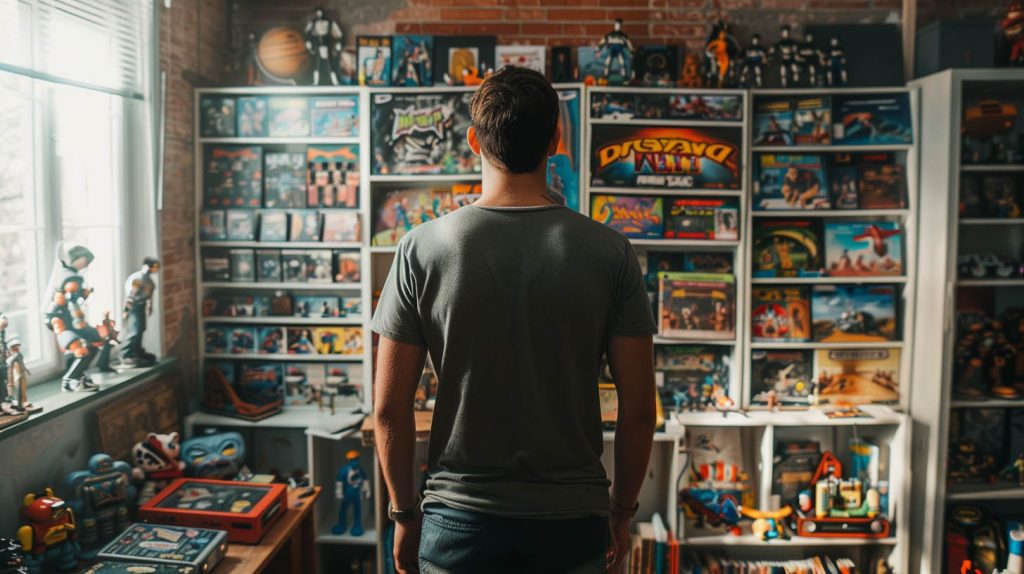When you buy through our links, we may earn a commission. Learn more.
Understanding Vintage Toy Accessories
Vintage toy accessories are essential elements that enhance the value and appeal of our favorite collectibles. They often represent specific moments in pop culture, connecting fans to cherished memories. Knowing the key manufacturers, popular lines, and how to recognize authentic pieces can greatly aid our collecting journey.
The Appeal of Vintage Collectibles
The allure of vintage toy accessories comes from their nostalgia and significance in pop culture. Many of these accessories completed iconic toy lines like G.I. Joe, Transformers, and Star Wars action figures.
Collectors seek original pieces because they tell a story. Accessories can range from vehicles and playsets to weapons and outfits. These items often showcase details that make our toys more enjoyable and visually appealing.
For example, accessories for:
- Star Wars: Lightsabers and spacecraft.
- G.I. Joe: Vehicles and gear for the action figures.
- Transformers: Weapons and additional parts for transformations.
The demand for these pieces is high. Complete sets with their accessories can fetch higher prices due to their rarity.
Key Manufacturers and Brands
Several manufacturers have significantly impacted the vintage toy market. Knowing these brands will help us identify and appreciate the accessories associated with them.
Top Brands:
- Hasbro: Known for G.I. Joe and Transformers.
- Kenner: Famous for the original Star Wars line.
- Mattel: Best known for Barbie but also produced action figure lines.
- Coleco: Known for their Cabbage Patch Kids and handheld devices.
- Matchbox: Made iconic vehicle accessories.
- LJN: Recognized for their WWF wrestling figures and accessories.
These brands created accessories that defined many childhoods. Recognizing and valuing these manufacturers adds depth to our collections.
Recognizing Authentic Accessories
To enhance our collecting experience, it’s crucial to identify genuine vintage toy accessories. This practice ensures we invest in authentic pieces that hold their value.
Key signs of authenticity:
- Markings: Look for stamps or logos indicating the manufacturer.
- Material: Vintage accessories often have a different feel compared to modern reproductions.
- Condition: Items in original packaging or mint condition are more valuable.
- Documentation: Original manuals or promotional materials can verify authenticity.
For example, each vintage G.I. Joe accessory typically has specific markings that indicate its original release. Understanding these can prevent us from purchasing fakes and ensure we build a trustworthy collection.
Navigating the Vintage Toy Market
Understanding the vintage toy market is essential for collectors and fans. This section covers key aspects of buying and selling these cherished items, determining their value, and creating a collection that stands out.
Where to Buy and Sell
We have various options when it comes to buying and selling vintage toys. Here are some popular marketplaces:
- Online Auction Sites: eBay is a well-known platform for finding rare toys and accessories.
- Specialty Websites: Websites like Going Twice focus on toys specifically and offer a wider selection.
- Local Shops: Vintage toy stores often have unique items that aren’t sold online.
- Flea Markets: These can be treasure troves for finding hidden gems at lower prices.
When selling, we can list items on similar platforms or attend toy shows to connect directly with collectors.
Determining Value and Price
It’s important to know the value of our vintage toys before buying or selling. Here are some factors to consider:
- Condition: Items in mint condition fetch higher prices.
- Rarity: Limited edition or hard-to-find toys are more valuable.
- Market Trends: The value of toys can fluctuate based on trends. For example, action figures from the mid-1970s to mid-1990s are currently popular.
We can use price guides and databases to research current values. Keeping photos and descriptions handy helps in making informed decisions.
Creating Engaging Collections
Creating a collection that reflects our interests can be rewarding. Here are some tips:
- Focus on Themes: Consider collecting based on themes, such as toys from favorite movies or TV shows.
- Organize by Era: Arranging toys by the decade they were made adds historical context.
- Display Creatively: Use shelves or display cases to showcase your collection. Proper lighting can enhance the visual appeal.
Involving ourselves in collector communities can also provide inspiration and insights into expanding our collections.
I’m Cartez Augustus, a content creator based in Houston, Texas. I’ve been exploring a variety of niches in content marketing in order to increase website traffic. I enjoy experimenting with artificial intelligence, search engine optimization, and paid search. The process of creating nerd-related content has been extremely rewarding since it has enabled me to network with people who are knowledgeable about these subjects.

